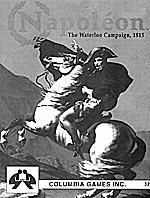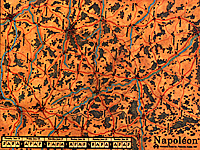 Title: Napoleon: The Waterloo Campaign 1815 (third edition)
Title: Napoleon: The Waterloo Campaign 1815 (third edition)
Designers: Tom Dalgliesh, Lance Gutteridge, and Ron Gibson
Number of Players: 2 or 3
Playing Time: 2-3 hours
Complexity Level: Low; good for beginners and non-wargamers
Packaging: Corrugated cardboard box with four-color color sleeve.
Zip-lock plastic bags for wooden block storage. Scale: Strategic-level maneuvering
with battles resolved on a tactical battle board. Units represent the three primary
leaders (Napoleon, Blucher, Wellington), brigades (Prussians) or divisions (French
and Anglo-Allied).
Map: Four-color 21- by 16-inch map, made of thick card stock which
folds into four sections for storage. Also, one four-color paper battle board for
resolving grand-tactical encounters. Map shows much of Belgium and a small part of
northeastern France. Individual towns and cities are denoted with major and
minor roads connecting them for movement.
Playing Pieces: 84 3/4-inch square wooden blocks; 25 gray (Prussians), 38 blue (French), and 19 red (British and other Allies). Peel-off stickers to apply to the blocks identify units and provide up to four levels of strength
Rule Book(s): 7 pages of rules plus onepage index in a 7-by-8 inch folder
Other Components: 4 six-sided dice
Scenarios: One, with historical and free set-ups
Historical Background Information: None, but an order of battle is provided for each army.
Publisher: Columbia Games Inc.
ISBN: None
List Price: $40.00
Summary: This game covers six days of the 1815 Waterloo campaign in an
elegant and simple design system. The wooden blocks used as playing pieces
give the added advantage of semihidden deployment and movement since unit
identification and strength is not revealed until combat. While succeeding as a
playable game, it comes up short as a historical simulation.
There are good reasons why Napoleon, having originally been designed over twenty years ago, has stood the test of time while so many of its coventional hexagon and cardboard counter rivals are now extinct.
One good reason is that the game is simple to play, a definite candidate for being one of the best introductory wargames ever made. It is also finely balanced, like the campaign itself, such that often times the game is going to be "a near run thing." Two reviewers played three tense and enjoyable games of Napoleon in a Saturday afternoon.
 Play is fast, point to point movement between the towns on the game map. Step reduction for losses is facilitated by simply turning the wooden block so that the current strength level is
at the top of the block. Each unit has a strength of from one to four points based on its historical size in men and the quality of troops.
Play is fast, point to point movement between the towns on the game map. Step reduction for losses is facilitated by simply turning the wooden block so that the current strength level is
at the top of the block. Each unit has a strength of from one to four points based on its historical size in men and the quality of troops.
To fight battles, you place pieces from the game map onto the tactical battle board and roll lots of dice: one for each unit's strength point. Napoleon is therefore reminiscent of the game Risk, while also providing the flavor of Napoleonic combat in a fun format. Infantry can form squares, cavalry can be devastating, and artillery can shatter a wavering sector of the enemy's battleline.
Many reasons can be listed why Napoleon resoundly fails as a historical simulation. There are almost no rules for supply, lines of communications (which were different for each army), or major sub- commanders such as Ney and Grouchy.
Neither do benefits exist for corps integrity nor penalties for dispersing the various elements of a command to the four winds. Provisions are lacking for the unique abilities of the French Imperial Guard and the superb discipline of the British infantry. Chain of command and order transmission are not accounted for, and a few ambiguous rules about combat caused confusion.
 Additionally, we were perplexed by historical errors on the map such as the road from Charleroi to Ligny being classified as "minor" when in actuality it was a major route of several roads that much of Napoleon's army traversed on 16 June to attack the Prussians.
Additionally, we were perplexed by historical errors on the map such as the road from Charleroi to Ligny being classified as "minor" when in actuality it was a major route of several roads that much of Napoleon's army traversed on 16 June to attack the Prussians.
If these historical features could have somehow been incorporated in a manner as elegent as the rest of the game, Napoleon could have been a benchmark in wargame design. As it stands, this game is excellent for beginners and an enjoyable diversion for veterans.
Back to Empire, Eagles, & Lions Table of Contents Vol. 2 No. 13
Back to EEL List of Issues
Back to MagWeb Master Magazine List
© Copyright 1995 by Emperor's Headquarters
This article appears in MagWeb (Magazine Web) on the Internet World Wide Web.
Other military history articles and gaming articles are available at http://www.magweb.com